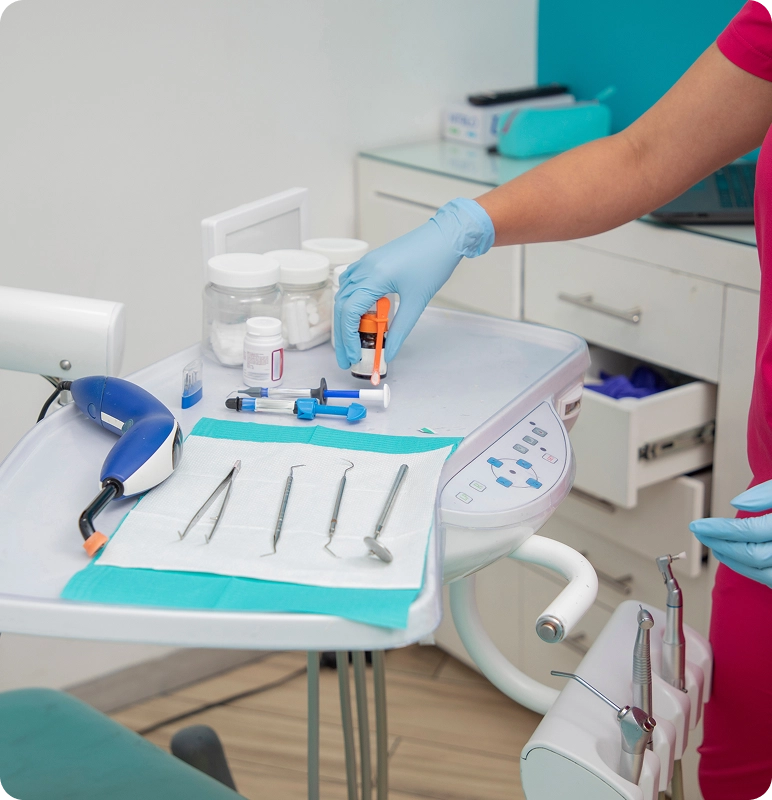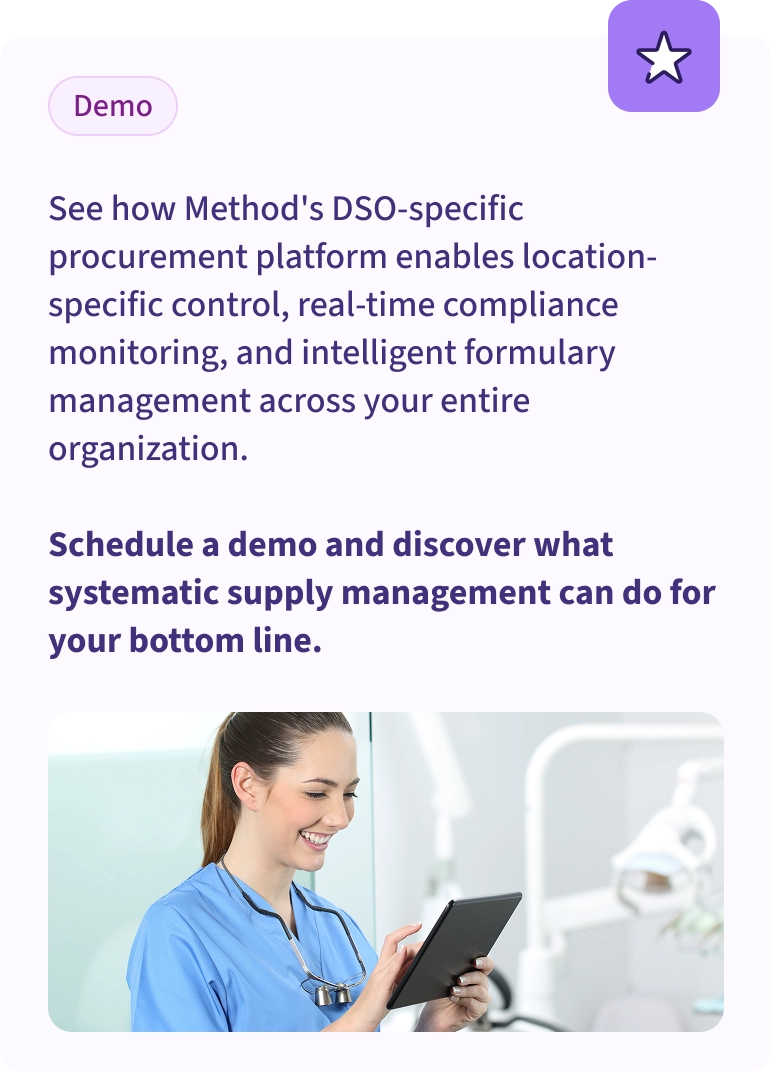
The DSO formulary paradox: Scaling your practice demands standardization, but clinical excellence requires flexibility.
Fortunately, standardizing supplies across multiple locations doesn’t have to mean sacrificing clinical excellence.
And it shouldn’t.
The practices that crack this code instead build systems and processes that deliver both. Here are the three essential elements that separate thriving multi-location practices from those stuck in procurement chaos.
There is one sacred rule in building a formulary that works: clinical decisions drive clinical product choices.
The business side cannot override the clinical side when patient outcomes are at stake.
This is why smart DSOs implement a dual-track approval process:
These include composites, bonding agents, and impression materials. They must pass clinical review board evaluation, with doctors testing alternatives and approving equivalents. The business team then identifies cost-effective options within clinically-approved choices.
Items like bibs, sterilization pouches, and office supplies can be mandated by the business team based on cost-effectiveness. No clinical approval is needed for standardization, allowing immediate implementation across all locations.

Form a clinical committee with representatives from each specialty and practice type in your organization. General dentists evaluate differently than oral surgeons.
Establish clear evaluation criteria focusing on patient outcome impact, ease of use for clinical staff, integration with existing workflows, and cost differential analysis.
Run parallel testing. Never switch entire organizations cold turkey. Test alternatives in select locations while maintaining current products elsewhere.

The magic number is 6.5%.
If your DSO is spending more than 6.5% of revenue on supplies, you're overspending. This single metric reveals everything about product waste and expiration, poor price negotiations, lack of formulary compliance, and inefficient ordering processes.
Every dollar saved in procurement equals $3-4 in production value.
So that $50,000 annual reduction in supply costs? That's equivalent to $150,000-200,000 in additional procedures you don't have to perform, headcount you don’t have to increase, and schedule management you don’t have to do.

Identify your top 20 products by spend across all locations. Negotiate volume pricing based on collective purchasing power. Standardize these high-impact items first.
Break spending into categories. Infection control offers the highest standardization opportunity. Restorative requires balancing clinical preference with cost. Specialty items need location-specific flexibility.
Track expiration rates by location, identify overordering patterns, and implement usage-based reorder points.

The worst thing that can happen? Your procurement system treats all locations identically. When Location A has compliance issues, Locations B-E get punished with restrictive ordering rules.
Smart DSOs demand technology that enables granular permission management with different approval workflows by location, supplier access control by region, and budget limits tailored to practice size and type.
They also require flexible formulary architecture with global formularies for organizational standards, location-specific formularies for provider preferences, and specialty formularies for orthodontics, oral surgery, and other specialties.

The problem is that practices make ordering decisions in isolation, without visibility into better alternatives or pricing.
The solution is technology that provides instant intelligence: price comparison across suppliers, alternative product suggestions based on clinically-approved options, compliance monitoring alerts, and usage analytics to optimize reorder points.
Track formulary compliance percentage by location, cost variance from negotiated pricing, private label adoption rates (target 30-40%), and supply spend as percentage of revenue.
Automate reorder notifications based on usage patterns, price alerts when better alternatives become available, compliance reporting for location managers, and ROI tracking on formulary changes.

Phase 1: Foundation (Month 1)
Audit current spend across all locations. Categorize products into clinical vs. non-clinical. Establish your clinical review committee.
Phase 2: Quick wins (Month 2)
Standardize all non-clinical products immediately. Negotiate volume pricing on your top 10 products by spend. Implement basic compliance tracking.
Phase 3: Clinical integration (Months 3-6)
Begin clinical trials for alternative products. Roll out approved alternatives location by location. Refine approval workflows based on feedback.
Phase 4: Optimization (ongoing)
Continuous product evaluation every 6 months. Quarterly compliance reviews with location managers. Annual formulary refresh based on usage data.

Manual formulary management across multiple locations is like performing surgery with butter knives—theoretically possible, practically impossible.
Modern DSOs need a unified procurement platform connecting all locations, automated compliance monitoring with real-time alerts, intelligent product matching showing alternatives and pricing, location-specific controls without system complexity, and analytics dashboards tracking formulary performance.
Start by calculating your current supply spend percentage. If you're above 6.5%, immediate action is needed. Even if you're below 6.5%, optimization opportunities still exist.
Audit your top 50 products by total organizational spend. Categorize them as clinical vs. non-clinical and identify standardization opportunities.
Evaluate your current technology capabilities. Can you track compliance by location? Do you have real-time price comparison? Can you implement location-specific controls?
Begin implementation based on your audit results within the first month.

Successful DSO formulary management isn't about choosing between clinical excellence and cost control—it's about building systems that deliver both.
The practices winning in today's market have learned that standardization without the right technology is just organized chaos. They've invested in platforms that make smart decisions automatic and compliance effortless.
Imagine the possibilities when your formulary management actually works across all locations. Every decision backed by real-time data. Every order optimized for both cost and quality. Every location operating efficiently while maintaining clinical autonomy where it matters.

